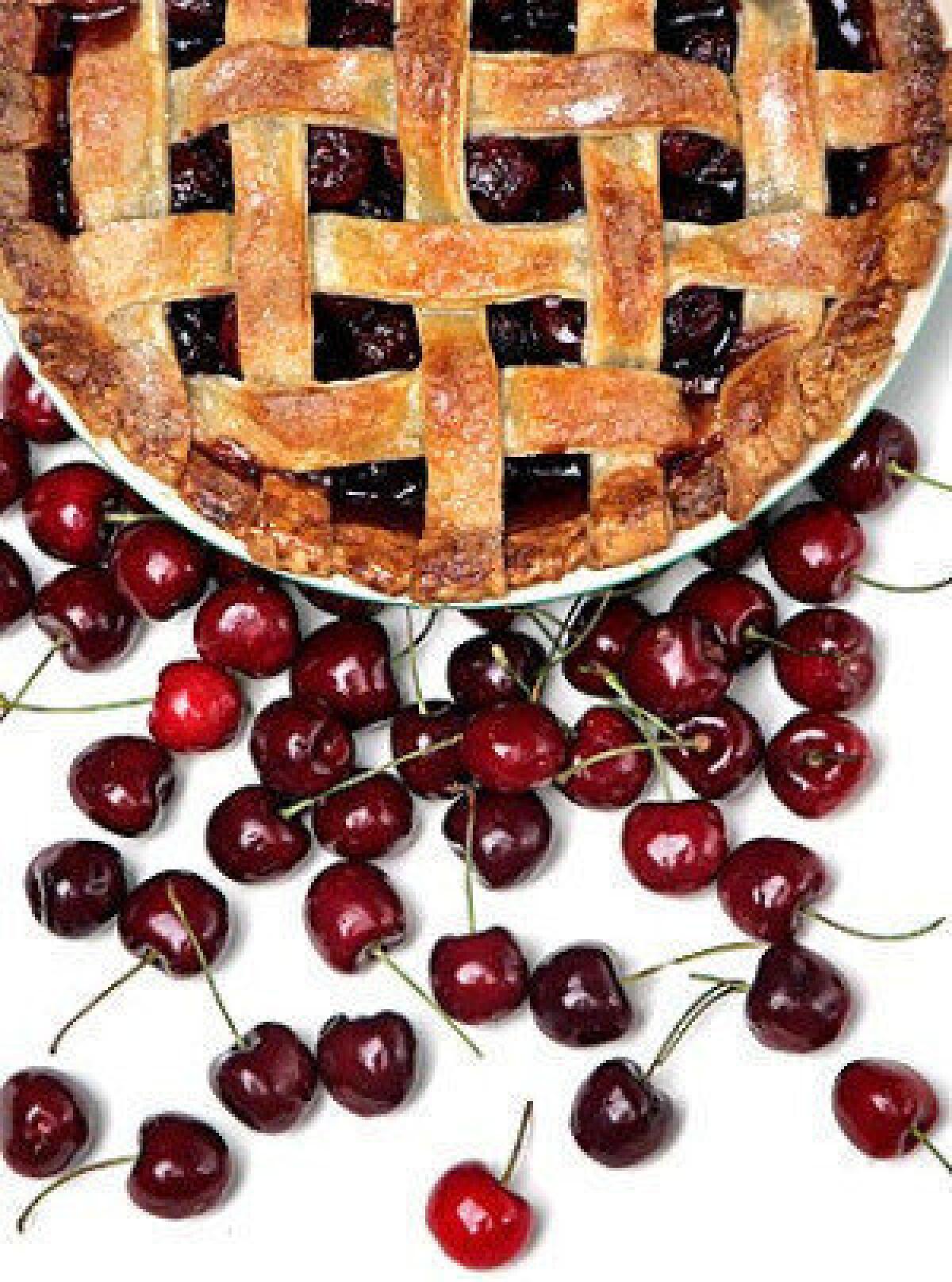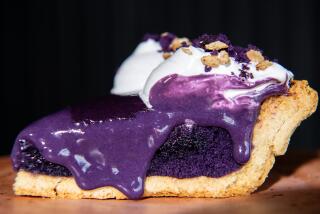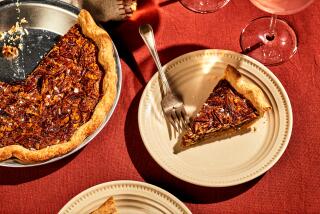Test Kitchen tip: Food processor for pie dough

- Share via
If you’ve never made a pie dough, or other quick doughs, in a food processor, I can’t stress how wonderfully simple and easy the whole process is. Add the dry ingredients to the bowl of a food processor and pulse a few times to combine. Add the cold butter chunks and give the processor a couple whirs to incorporate, then pulse in the liquid ingredients just to combine. The steps may vary slightly depending on the recipe, but that’s pretty much it. Voilà.
Many recipes now include dual methods for mixing -- mixing bowl and food processor methods. But even older recipes should work in a processor; it just takes a little adaptation. And a food processor is especially great if you’re pressed for time or are working in a warm kitchen.
If you do use a food processor, remember that the blades rotate quickly and that it’s easy to overprocess the dough, which will make it tough. I frequently pause between pulses to gauge where I am, just to make sure nothing is over-mixed before proceeding.
Continue reading below for recipes for single and double-crust pie dough.
If you have any kitchen tips or questions you’d like me to explore, leave a comment below or shoot me an email at noelle.carter@latimes.com.
ALSO:
Mac ‘n’ cheese recipes galore!
Go behind the scenes at the L.A. Times Test Kitchen
You can find Noelle Carter on Facebook, Google+, Twitter and Pinterest. Email Noelle at noelle.carter@latimes.com.
Flaky pie crust
Total time: 20 minutes, plus chilling time
Servings: This makes enough crust for 1 (9- to 10-inch) pie
Note: The cider vinegar is used to help “shorten” the crust, improving the texture. Though you might smell the vinegar as you roll out the crust, you should not taste or smell it in the finished pie.
Single crust
1½ cups (6.4 ounces) flour
3/4 teaspoon salt
2 teaspoons sugar
3 tablespoons cold shortening
5 tablespoons cold butter, cut into 1/2-inch cubes
1½ teaspoons cider vinegar
3 to 4 tablespoons ice water, more if needed
1 egg or egg white, for an egg wash, if desired
1. To make the dough using a food processor, pulse together the flour, salt and sugar until thoroughly combined. Add the shortening and pulse until incorporated (the dough will look like moist sand). Add the butter and pulse just until the butter is reduced to small, pea-sized pieces. Sprinkle the vinegar and water over the mixture, and pulse once or twice until incorporated. Remove the crumbly mixture to a large bowl and gently press the mixture together with a large spoon, rubber spatula or the palm of your hand just until it comes together to form a dough. Mold the dough into a disc roughly 6 inches in diameter. Cover the disc tightly with plastic wrap and refrigerate at least 2 hours, preferably overnight.
To make the dough by hand, whisk together the flour, salt and sugar in a large bowl. Add the shortening and incorporate using a pastry cutter or fork (the dough will look like moist sand). Cut in the butter just until it is reduced to small, pea-sized pieces. Sprinkle the vinegar and water over the mixture, and stir together just until incorporated. Gently press the crumbly mixture together with a large spoon, rubber spatula or the palm of your hand just until it comes together to form a dough. Mold the dough into a disc roughly 6 inches in diameter. Cover the disc tightly with plastic wrap and refrigerate at least 2 hours, preferably overnight.
2. On a lightly floured surface, roll out the dough into a round roughly 13 to 14 inches in diameter. Place in a 9- to 10-inch baking dish, trimming any excess and crimping the edges as desired. (One trick I use is to roll out the dough onto well-floured parchment or wax paper, invert and center the pie dish over the dough and then flip the dough into the dish.) Brush the outer edge of the shell with the egg wash, then freeze the formed shell for 20 to 30 minutes before filling and baking.
3. If prebaking (or blind-baking) the crust, line the shell with foil and fill with pie weights. Bake in a 400-degree oven for 20 minutes, then remove the weights and foil, prick the sides and bottom several times with a fork and continue baking until the bottom of the crust is dry and lightly colored, 5 to 10 minutes more.
Each of 8 servings, without egg wash: 193 calories; 2 grams protein; 18 grams carbohydrates; 1 gram fiber; 12 grams fat; 6 grams saturated fat; 19 mg. cholesterol; 1 gram sugar; 220 mg. sodium.
Double crust
3 cups (12.75 ounces) flour
1½ teaspoons salt
1 tablespoon plus 1 teaspoon sugar
1/4 cup plus 2 tablespoons cold shortening, cut into 1/2-inch cubes
1/2 cup plus 2 tablespoons (1¼ sticks) cold butter, cut into 1/2-inch cubes
1 tablespoon cider vinegar
6 to 8 tablespoons ice water, more if needed
Filling
1 egg or egg white, for an egg wash, as desired
Sugar, for sprinkling, if desired
1. To make the dough using a food processor, pulse together the flour, salt and sugar until thoroughly combined. Add the shortening and pulse until incorporated (the dough will look like moist sand). Add the butter and pulse just until the butter is reduced to small, pea-sized pieces. Sprinkle the vinegar and water over the mixture, and pulse once or twice until incorporated. Remove the crumbly mixture to a large bowl and gently press the mixture together with a large spoon, rubber spatula or the palm of your hand just until it comes together to form a dough. Mold the dough into a disc roughly 6 inches in diameter. Cover the disc tightly with plastic wrap and refrigerate at least 2 hours, preferably overnight.
To make the dough by hand, whisk together the flour, salt and sugar in a large bowl. Add the shortening and incorporate using a pastry cutter or fork (the dough will look like moist sand). Cut in the butter just until it is reduced to small, pea-sized pieces. Sprinkle the vinegar and water over the mixture, and stir together just until incorporated. Gently press the crumbly mixture together with a large spoon, rubber spatula or the palm of your hand just until it comes together to form a dough. Mold the dough into a disc roughly 6 inches in diameter. Cover the disc tightly with plastic wrap and refrigerate at least 2 hours, preferably overnight.
2. Halve the dough, keeping the second half refrigerated as you work on the first half.
3. On a lightly floured surface, roll half the dough out into a round roughly 13 to 14 inches in diameter. Place in a 9- to 10-inch baking dish, trimming any excess so the edge of the crust meets the edge of the pan. (One trick I use is to roll out the dough onto well-floured parchment or wax paper, invert and center the pie dish over the dough and then flip the dough into the dish.)
4. Fill the pie as desired and brush the edge of the crust with the egg wash or water, then refrigerate the pie as you roll out the second dough half.
5. Roll the second dough half as you did the first. Remove the pie from the refrigerator, and center the top half over the filling. Press the top crust along the egg wash-brushed edge of the bottom crust to seal, then trim the excess top crust so that it extends from the edge of the pie plate by one-half inch. Fold this edge and tuck it under the bottom crust to seal the crust completely. Crimp the edges as desired. Brush the top crust with the egg wash, and sprinkle over sugar if desired. Slit the top crust to create vents for the filling as it bakes.
6. Refrigerate the formed shell for 20 to 30 minutes before baking.
Each of 8 servings, without filling or egg wash: 385 calories; 5 grams protein; 37 grams carbohydrates; 1 gram fiber; 24 grams fat; 12 grams saturated fat; 38 mg. cholesterol; 2 grams sugar; 439 mg. sodium.
More to Read
Eat your way across L.A.
Get our weekly Tasting Notes newsletter for reviews, news and more.
You may occasionally receive promotional content from the Los Angeles Times.










